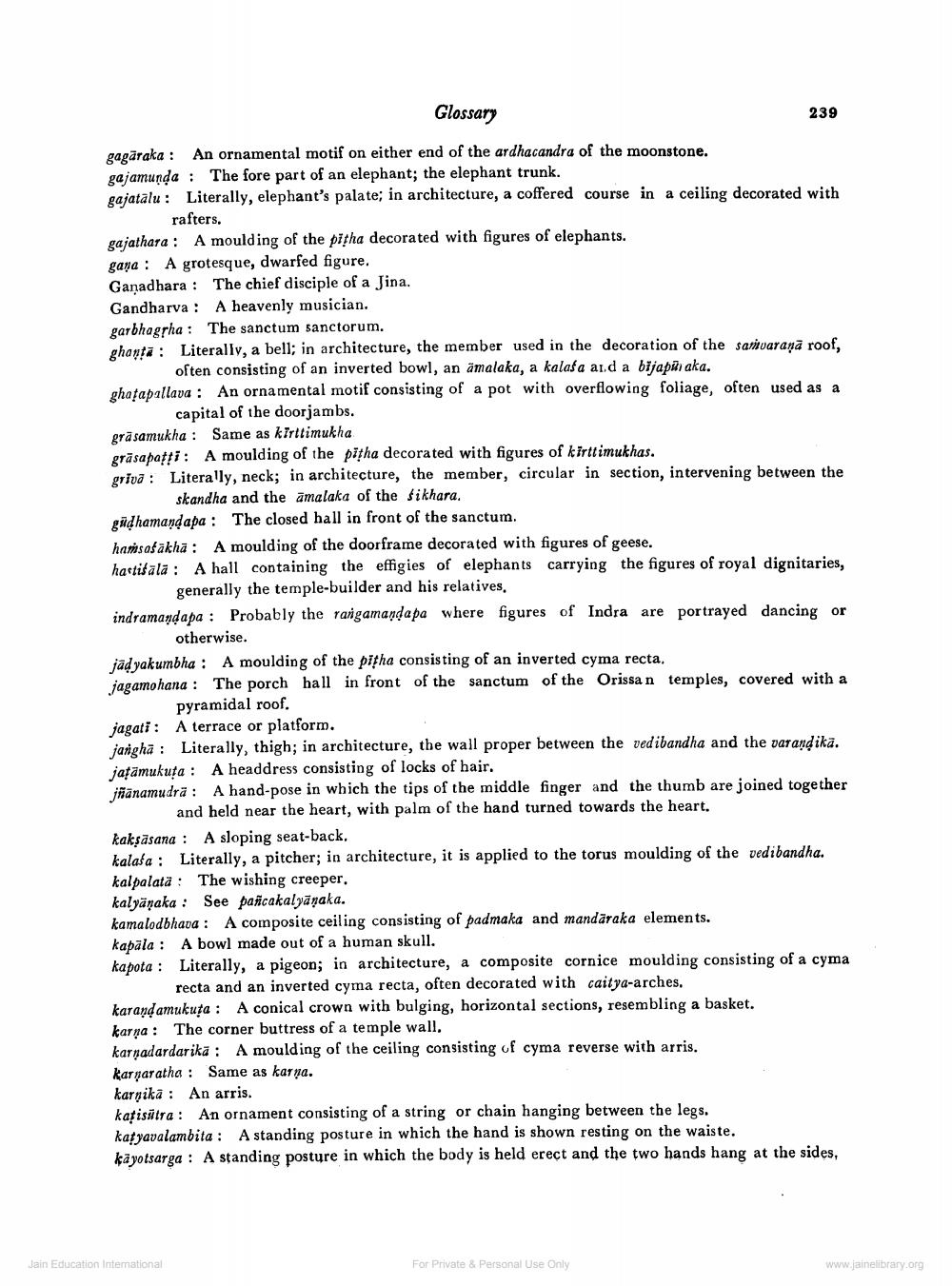________________
Glossary
239
gagāraka : An ornamental motif on either end of the ardhacandra of the moonstone. gajamunda : The fore part of an elephant; the elephant trunk. gajatalu: Literally, elephant's palate; in architecture, a coffered course in a ceiling decorated with
rafters. gajathara : A moulding of the pitha decorated with figures of elephants. gana: A grotesque, dwarfed figure. Ganadhara : The chief disciple of a Jina. Gandharva : A heavenly musician. garbhagyha: The sanctum sanctorum. ghantā : Literally, a bell; in architecture, the member used in the decoration of the samvaraņā roof,
often consisting of an inverted bowl, an amalaka, a kalafa and a bijapi aka. ghatapallava : An ornamental motif consisting of a pot with overflowing foliage, often used as a
capital of the doorjambs. grasamukha : Same as kirttimukha grāsapatti: A moulding of the pitha decorated with figures of kirttimukhas. griva : Literally, neck; in architecture, the member, circular in section, intervening between the
skandha and the amalaka of the Sikhara. gūdhamandapa: The closed hall in front of the sanctum. hamsafakha: A moulding of the doorframe decorated with figures of geese. hartisala: A hall containing the effigies of elephants carrying the figures of royal dignitaries,
generally the temple-builder and his relatives, indramaydapa: Probably the rangamanda pa where figures of Indra are portrayed dancing or
otherwise. jadyakumbha : A moulding of the pitha consisting of an inverted cyma recta. jagamohana : The porch hall in front of the sanctum of the Orissa n temples, covered with a
Pyramidal roof. jagati: A terrace or platform. jangha : Literally, thigh; in architecture, the wall proper between the vedibandha and the varandika. jațāmukuta : A headdress consisting of locks of hair. jñānamudra : A hand-pose in which the tips of the middle finger and the thumb are joined together
and held near the heart, with palm of the hand turned towards the heart. kaksāsana : A sloping seat-back, kalata : Literally, a pitcher; in architecture, it is applied to the torus moulding of the vedibandha. kalpalata : The wishing creeper. kalyanaka : See pañcakalyānaka. kamalodbhava: A composite ceiling consisting of padmaka and mandaraka elements. kapāla: A bowl made out of a human skull. kapota : Literally, a pigeon; in architecture, a composite cornice moulding consisting of a cyma
recta and an inverted cyma recta, often decorated with caitya-arches. karand amukuta : A conical crown with bulging, horizontal sections, resembling a basket. karya : The corner buttress of a temple wall. karşadardarika: A moulding of the ceiling consisting of cyma reverse with arris. karparatha : Same as karya. karyikā : An arris. kațisätra : An ornament consisting of a string or chain hanging between the legs. katyavalambita: A standing posture in which the hand is shown resting on the waiste. kayotsarga : A standing posture in which the body is held erect and the two hands hang at the sides,
Il till alla
Jain Education International
For Private & Personal Use Only
www.jainelibrary.org




